If there's one thing we love to do after traveling, it's eat! And we know that a visit to Santa Marta is much more than just a relaxing vacation on the beach.
Santa Marta is one of the cities of the Colombian Caribbean coast that offers a rich variety of typical foods with an important heritage that refuses to disappear, so in your visit to the city you will have the perfect opportunity to taste all these traditional flavors, some of which have several centuries of history.
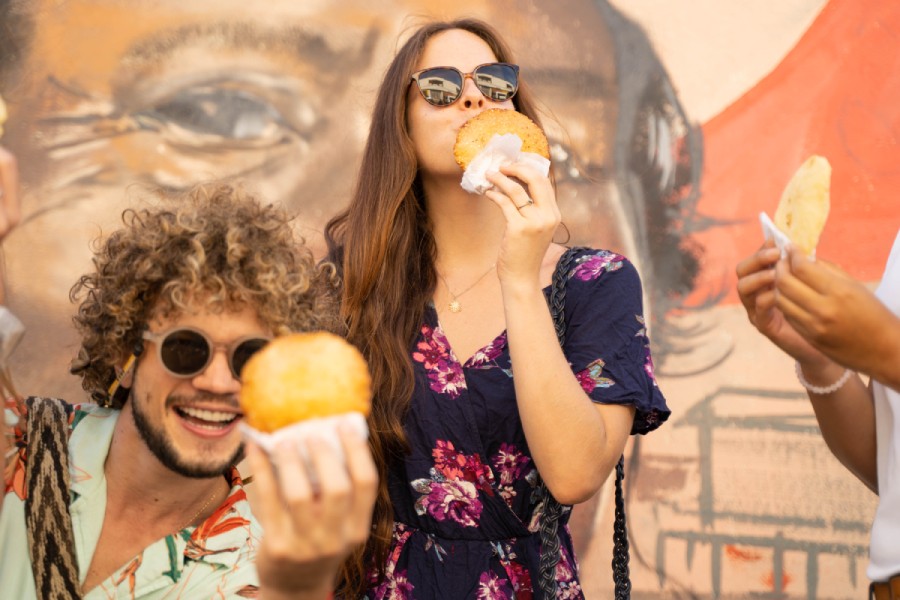
Santa Marta's gastronomy is the result of a culinary blend of three cultures: African, Spanish and indigenous, materialized in unique textures, smells and tastes. Join us on this tour of the best typical foods of Santa Marta so that you can enjoy them on your next visit!
If you are in a rush or simply want to have a handy list of the typical food we recommend you to taste while visiting Santa Marta, we left it to you below:
Cayeye or green banana mote.
Fried food: egg stuffed arepas, cheese sticks, empanadas and carimañolas
Patacones with cheese, sour cream, or fish
Cazuela de mariscos and fish soups
Coconut rice with fried fish
Drinks: tinto, panela water and fruit juices
Caribbean desserts and sweets: enyucado, arroz con leche (rice with milk) and coconut candy
Come and taste the flavors of Santa Marta! Here we will tell you in detail about the ingredients and the preparation of each of these traditional foods of Santa Marta:
Cayeye is a delicious and very popular dish that you can't miss when you are in Santa Marta. This typical dish is a true delight of the coastal gastronomy and is made with green bananas, a fruit highly appreciated in the Caribbean.
Cayeye is prepared by cooking green bananas in salted water and mashing it to obtain a smooth and delicious puree that is topped with the regional cheese (queso costeño), ‘hogao’ (tomato and onion stew) or even pork rinds.
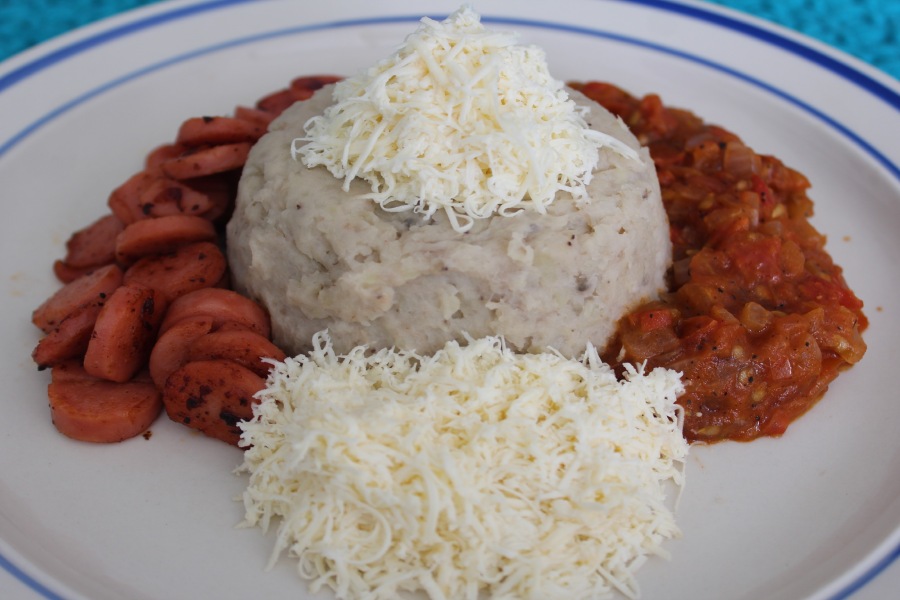
Cayeye with hogao, ranchera sausage and coastal cheese.
Green bananas are also used to make tajadas, which are made with sliced guineo and fried until golden brown and crispy; for locals, they are the perfect accompaniment to any meal. Whether you enjoy them with grilled meat, chicken, salpicon fish or on their own, the unique flavor and crunchy texture of tajadas will delight your palate. Try them and discover why they are the perfect complement to the typical cuisine of Santa Marta!
In Santa Marta, green bananas are a versatile ingredient. They also prepare tajaditas and patacón, about which we will tell you more later. As far as drinks are concerned, green banana is used to prepare mazamorra, a kind of thick and creamy drink with a sweet taste that is usually part of the meals for babies and children at home.
Fritos are an important part of the gastronomy of Santa Marta. They are a variety of fried foods that can be found in almost every corner of the city. Some of the most popular fritos in Santa Marta are empanadas, which can be filled with cheese, meat, chicken or fish. You can also find the traditional Colombian buñuelos, and others similar in shape, less common, known as matrimonio, which are corn balls filled with cheese.
Other popular fried foods in Santa Marta are fried arepas, the most famous being the arepa de huevo (egg stuffed arepa). Known by locals as "arepa e' huevo", this is one of the most traditional foods of the Caribbean region. It consists of a delicious arepa made of corn dough filled with egg.
This tasty typical dish starts with a disc of corn dough (arepa), that is fried until it’s slightly crispy and inflated. Before it is fully cooked, you have to remove it from the hot oil. Next, make a small hole, crack an egg into it, and seal it with a little bit of dough. Then, return the arepa to the hot oil to finish cooking. When it’s golden brown, and the egg is cooked on the inside, it is ready to enjoy. This type of egg arepa is also made with sweet dough, which gives it a different flavor.

Sweet egg arepas.
Among the variety of fritos that you can find in Santa Marta are carimañolas, which are similar to empanadas but made of yucca, stuffed with meat or cheese, cheese sticks, stuffed potatoes and stuffed patacones.
Fritos are a delicious option to enjoy as an appetizer or a quick street breakfast, and without a doubt should be on your list when you come to taste the typical food of Santa Marta. Fritos in any of their presentations are a true delight of the northern coast gastronomy that we invite you to try!
Patacón is another typical dish of the Samarian cuisine, and among the most famous preparations are the patacón stuffed with egg, meat or chicken, the patacón with fish salpicón, which combines two classic dishes of the coastal gastronomy: the patacón and the fish salpicón. And the most traditional, the patacón with regional cheese.
The patacón or tostón (as it is called in other parts of the Caribbean) is made with green banana or plantain, which is fried and crushed to obtain a kind of crunchy disk.
Patacones with fish salpicón.
To make the patacones, cut the plantains or green bananas into thick slices and fry them until golden brown. They are then removed from the oil and, while still hot, are crushed with a flat object such as a mortar or a chopping board to re-fry them so that they are crispy on the outside and soft on the inside. Patacones can be seasoned with salt, garlic, or other spices. They can be enjoyed alone or with a variety of sauces, such as guacamole, remoulade or the famous salsa rosada.
Patacones are a true coastal delicacy and another example of the culinary richness of the region, which can be found in many restaurants and food stalls in Santa Marta and throughout the Caribbean, and is definitely a dish worth trying.
The list of typical dishes of Santa Marta also includes fish soups, cazuelas de mariscos (seafood casseroles) and fish stew. The latter is one of the most famous of the coast, it is a thick and very tasty stew, which is prepared with fish, yucca, plantain or green banana, onion, cilantro and other typical ingredients of the region.

Cazuela de Mariscos.
Due to its proximity to the sea and the variety of fish that inhabit this area of the Caribbean, we recommend you also taste a good seafood casserole, which is a mixture of more than 7 marine species, among which are the octopus, snail, palm heart and shrimp, flavors that combine the best of the sea of Santa Marta with other ingredients such as cream, giving it a unique and delicious flavor.
The fish soups and seafood in general are a true delight that you must try during your visit to Santa Marta, because the typical flavors of the region are waiting to give you the best of Santa Marta’s gastronomy.
This is one of the most popular and typical dishes of Santa Marta cuisine. It consists of fried fresh fish served with rice cooked in coconut milk, accompanied by fried ripe plantains and fresh salad. The fish is from the region, it can be Mojarra, Snapper or Snook, and is prepared with spices and lemon to enhance its flavor.
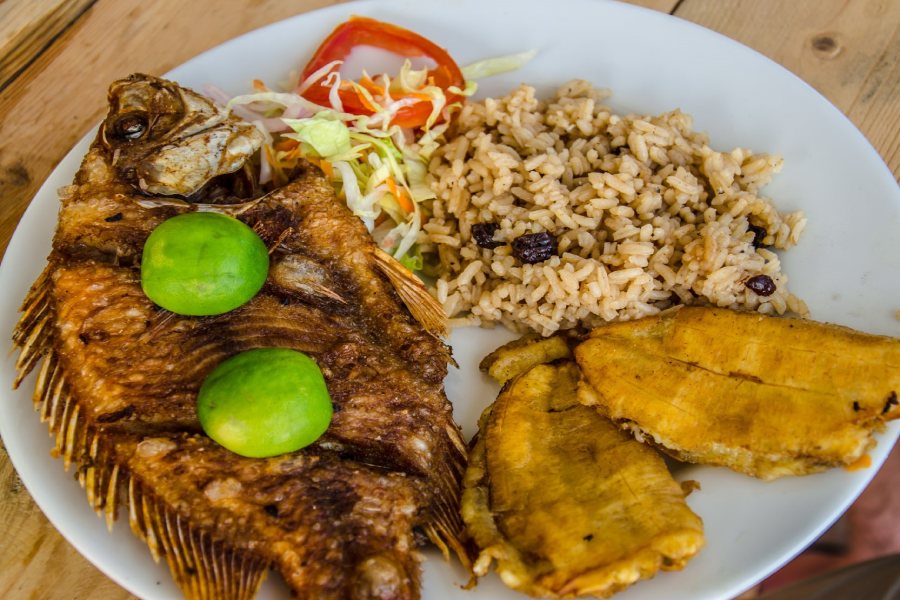
Fried fish with coconut rice and patacones.
The coconut rice is creamy and slightly sweet, contrasting with the salty and crunchy taste of the fish. This dish is a delight that shows the diversity of the typical cuisine of Santa Marta and is a culinary experience that is the best option to try after a day at the beach.
Another of the delicacies that make up this list of typical tastes of Santa Marta are the natural juices. After tasting the egg stuffed arepas, cayeye or fish salpicón, refresh your throat with a delicious local fruit juice.
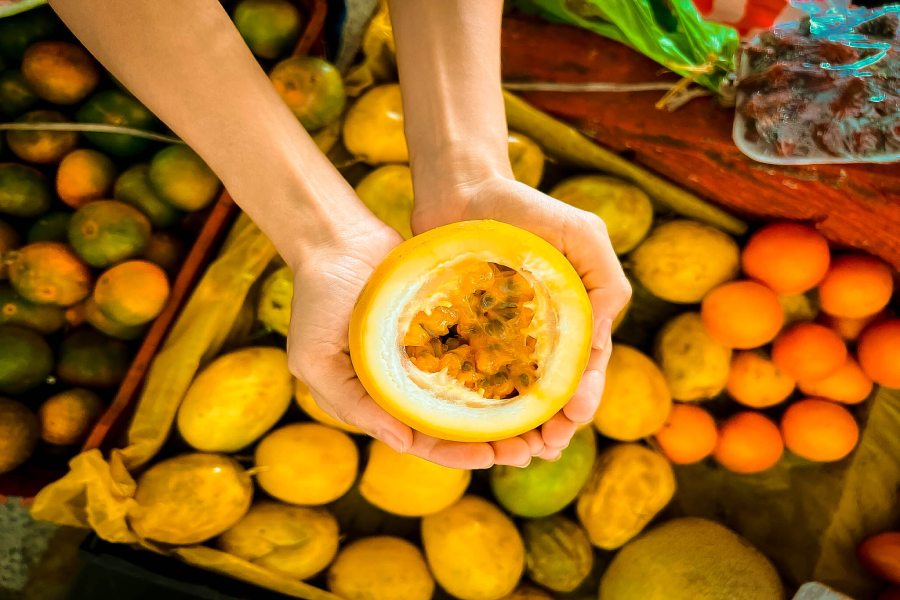
Maracuyá (passion fruit).
In Santa Marta, natural fruit juices are a very popular and refreshing drink that can be found in almost every corner of the city. The region has a great variety of exotic and tropical fruits that make the juices especially delicious.
We recommend that you try the lulo juice, passion fruit juice, mango juice and sapote juice!
In Santa Marta, aguapanela with lemon is one of the most traditional and refreshing drinks, usually served at lunch, but locals love it at any time of the day.
This drink is made from panela, a sweet paste made from sugar cane, water and fresh lemon juice. The panela is dissolved in hot water and mixed with lemon juice to create a drink that combines sweet and sour at the same time. Aguapanela with lemon is usually served in a glass with ice and is enjoyed as a refreshing drink on hot days, making it a popular drink among locals and visitors to Santa Marta.
Coffee is a very popular beverage in Colombia, and Santa Marta is not the exception. Due to its proximity to the Sierra Nevada de Santa Marta it is possible to taste coffee cultivated in the same region. This coffee is known for its unique flavor and sweet aroma, thanks to the climatic conditions and fertile soil in which it is grown.

Cappuccino.
This drink is served hot and is a delicious way to enjoy a moment of tranquility in this beautiful coastal city. In addition to hot coffee, the most common way to drink coffee in the city, recently we find more and more options to drink it in other preparations. For example, frappés are also a favorite drink of the Santa Marta people, especially on the hottest days.
On rainy and cooler days, one of the most popular drinks in Santa Marta is hot chocolate. This comforting drink is a delicious way to enjoy the usually cooler days and is regularly prepared at home, but you can also find it in the city's restaurants.
If you want to experience the authentic taste of coffee from the Sierra Nevada de Santa Marta, don't hesitate to visit Vívolo. Located in the store at Calle 22 # 1 C - 15, in Santa Marta, Colombia (Casa Marina), Vívolo offers an exquisite selection of coffee grown in this unique region. Discover more about their products and the passion they put into each cup by visiting their website at vivolocafe.com .Immerse yourself in the true essence of coffee with Vívolo and enjoy an unparalleled sensory experience.
Santa Marta's traditional desserts and sweets are a sample of the rich culture of the region. As we shared at the beginning of the article, these sweets, such as coconut, are a legacy of the culture of the Afro descendants who settled in the city, so you will definitely find unique flavors that have been preserved over the years.
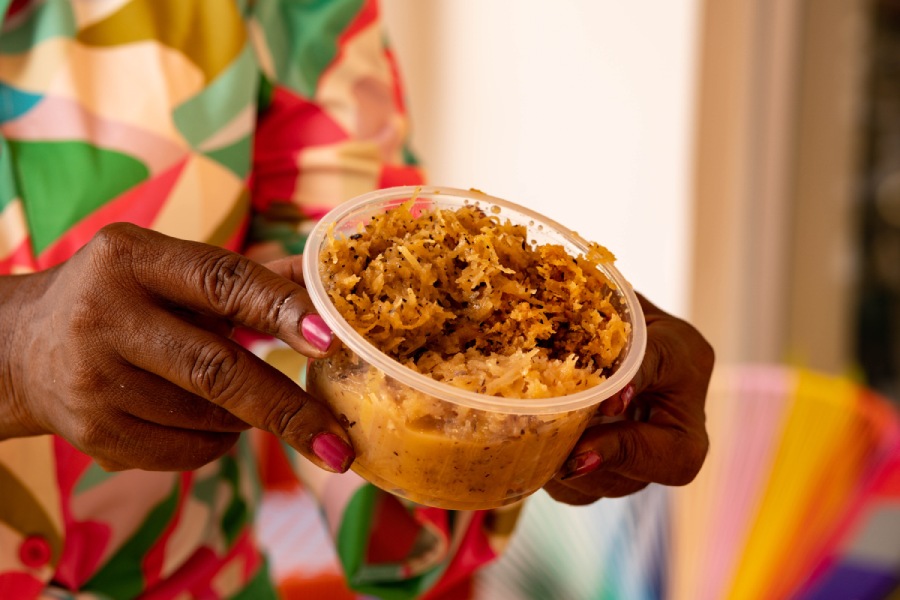
Coconut artisanal candy.
One of the most popular traditional sweets is the coconut candy, which is made mainly with grated coconut, panela and other spices such as cinnamon and cloves. This sweet is boiled until it caramelizes, creating a dessert that is not only delicious, but also sweet and aromatic. It is also usually made from pieces of ripe mango with cinnamon and clove, basically following the technique of coconut candy, simmered until it forms a sweet and delicious paste.
Another typical sweet that can be found in Santa Marta is the tamarind ball, which is one of the most popular. It is a mixture of tamarind pulp that is formed into a round shape and dried in the sun.
The variety of sweets you can find in the North Coast of Colombia is a universe of tastes and textures, they are so creative, there are even sweets made of root vegetables or legumes!
As for typical desserts, rice pudding is made with rice, milk, cinnamon and raisins. Its consistency is creamy and sweet, a delicious way to end a typical meal in Santa Marta.
To conclude this section of typical sweets and desserts, we invite you to try the enyucado, a delicious coastal specialty. Its main ingredient is yucca and it is accompanied by ingredients such as coconut, cinnamon, sugar and coastal cheese. It is a type of cake that you must try.
Many preparations above are not exclusive to the Santa Marta cuisine, they are also part of the traditional cuisine of the Colombian Caribbean. Nonetheless, there is an ingredient that makes a difference in the local cuisine: green bananas.

Green banana peeled.
The Africans who arrived in America were the ones who introduced this food in Colombian cuisine, mainly in the Pacific and Caribbean regions. In Magdalena, this fruit became popular when several banana companies arrived in the region, giving rise to what would become the distinctive preparations of the traditional dishes of Santa Marta and the region where the crops and transportation of bananas developed.
When the Spaniards arrived, they brought with them cattle and pigs, and consequently the use of meat and dairy products in the dishes of Santa Marta and Magdalena department. This in combination with African techniques made possible the current preparations of ‘cayeye’ and other traditional dishes.
Let's talk about one of the most important ingredients of Colombian cuisine, which dates back to pre-Columbian times: corn. The indigenous peoples who inhabited what is now Colombian territory before the arrival of the Spaniards already cultivated and consumed corn as their main food.
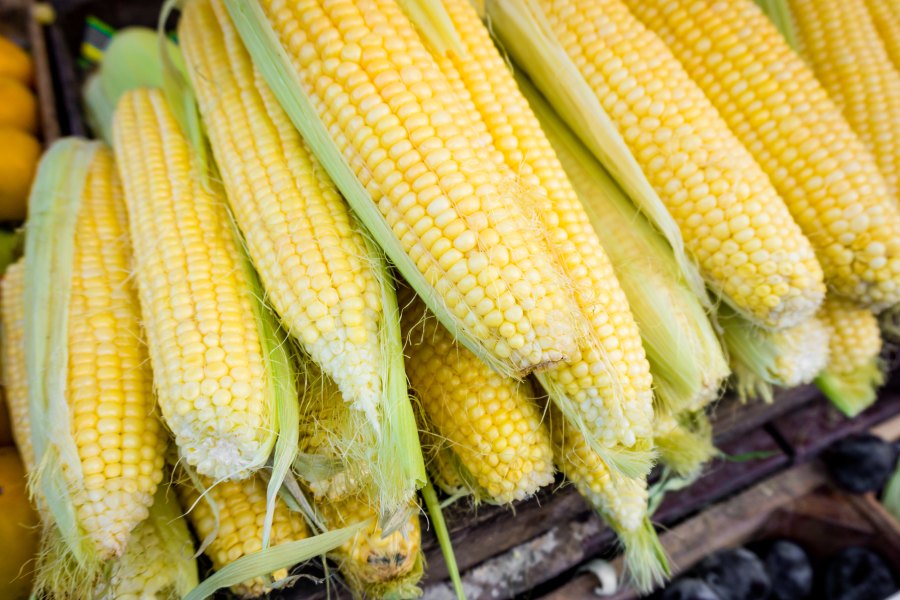
Corn cobs.
Corn has also been a fundamental ingredient in Colombian gastronomy in general. Today, corn is used in a wide variety of dishes in the Magdalena region, from the traditional arepas, to empanadas, bollos and more. The versatility of corn in Colombian cuisine has allowed it to remain one of the most important ingredients in the region and throughout the country.
An important fact about the famous arepa de huevo is that this typical food of the region is the result of an important culinary heritage, since it combines the influence of the native corn, the egg tortillas brought by the Spanish and African fried foods. This gastronomic delight has been passed down from generation to generation for almost 200 years!
Fish and seafood in Santa Marta has a long history, dating back to the indigenous peoples who inhabited the region and who included fish and seafood in their diet. With the arrival of the Europeans, fishing continued to be an important activity, giving way to the creation of new culinary preparations.
Tray of fried fish, coconut rice, salpicón, salad and patacones.
One of the most iconic preparations of Santa Marta's typical food is sancocho de pescado, which mixes seafood with local ingredients such as cassava. You can also find fried fish, shrimp ceviche, seafood casseroles and fish salpicon.
The region of Santa Marta and Magdalena is known for being rich in tropical fruits, thanks to its warm and humid climate that favors their cultivation. Some of the most popular fruits in this area are soursop, mango, papaya, pineapple, passion fruit, sapote, among others.

Lulo.
Some tropical fruits are not native to the region, but were brought by Europeans during the colonial period, who introduced them for consumption. However, these fruits adapted perfectly to the climate and soil of the area and became a fundamental part of the local cuisine, consumed mainly in natural juices.
The history of coffee in Santa Marta dates back to colonial times, when the European colonizers introduced the coffee plant in the region. In the Sierra Nevada de Santa Marta before coffee, sugar cane was planted, but it was the English, French, Dutch and Germans who arrived from the interior of the country, and, captivated by the Sierra Nevada, promoted the development of coffee cultivation.

Coffee beans.
Since then, coffee has become one of the main economic activities of the region, with many small producers dedicated to its production.
Santa Marta coffee is characterized by high quality, with a distinctive taste and aroma, which makes it highly appreciated throughout the region. The majority of coffee producers use traditional methods of cultivation and harvesting, which allows them to obtain high quality coffee beans.
The traditional sweets in Santa Marta are the result of a mixture of the culinary traditions of the indigenous peoples, the Spanish colonizers and the African population brought as slaves during the colonial period.
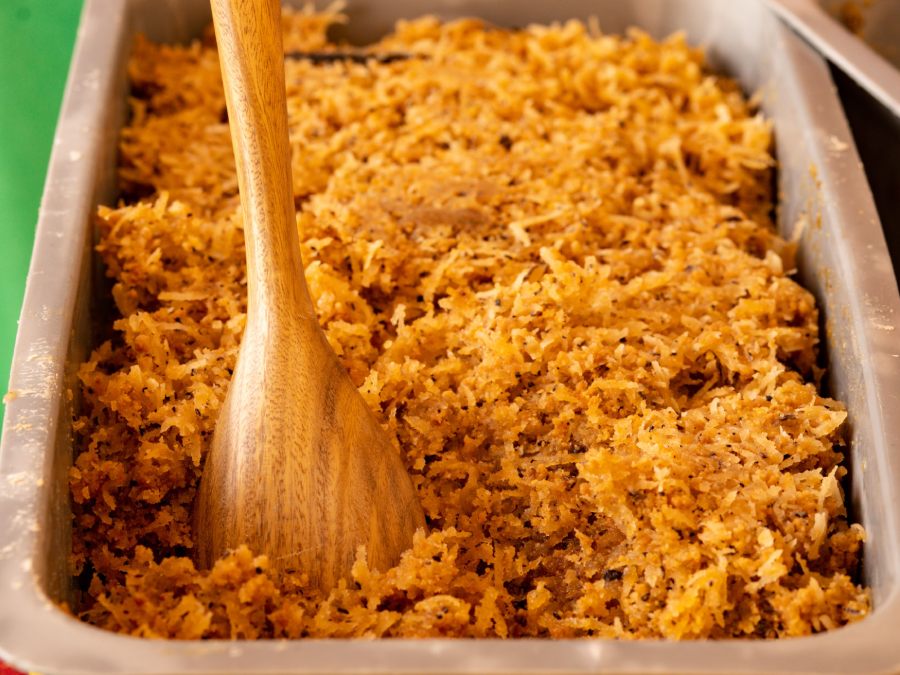
Coconut candy in a tray.
The African influence in the gastronomy of Santa Marta can be clearly seen in the preparation of sweets and desserts. One of the most popular sweets in the region is "dulce de coco", which consists of grated coconut cooked with panela or sugar. This preparation is very popular throughout the Caribbean and is a legacy of African culinary traditions.
In Visit Santa Marta we accompany you to taste these typical foods of the city in the best places, so you can learn to eat like a Samario. We invite you to enjoy an experience full of flavors where we also tell you their history, so you can fully taste each of these dishes.
In addition, at the end of the tour, we will surprise you with a delicious traditional dessert, so that your gastronomic experience will end on a sweet note. Without a doubt, there are many reasons to choose Santa Marta, but one of the best ways to do it is through its gastronomy, we are waiting for you!
If you want us to help you customize your trip and live an adventure in Santa Marta, contact us for more information at reservas@visitsantamarta.com.